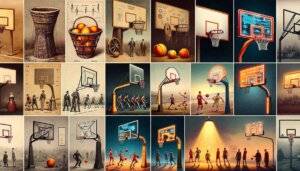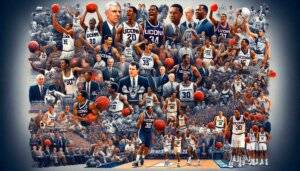The Evolution of Basketball Goals
You've always loved the game of basketball, from being a star player on your high school team to watching NBA games on TV. But have you ever stopped to think about the evolution of the basketball goals themselves? As the game of basketball has evolved over the years, so too have the goals that players shoot at. From simple peach baskets hung on the wall to the sleek and modern hoops we see in NBA arenas today, the basketball goal has come a long way. In this article, we'll take a closer look at the fascinating journey of the basketball goal throughout history.

Early Basketball Goals
Introduction of the Peach Basket
In the early days of basketball, the game was played with peach baskets as goals. Imagine playing a game without a net or backboard – that's how it all started! Invented by Dr. James Naismith in 1891, the peach basket was an improvised solution for a goal. Players had to retrieve the ball manually every time it went through the bottom of the basket. It was a far cry from the modern basketball goals we know today.
Improvements on the Peach Basket
As the popularity of basketball grew, players and enthusiasts realized the need for modifications to the antiquated peach basket goal. The first change came in 1893 when Senda Berenson Abbott, an early women's basketball pioneer, suggested the addition of a net to capture the ball after a successful shot. This innovation made the game more efficient and allowed players to continue playing without interruptions.
Introduction of the Backboard
The development of the backboard in 1893 by Henry Porter revolutionized the game of basketball. It provided a surface for players to rebound missed shots and helped define the boundaries of the court. The backboard also enhanced safety by preventing the ball from flying out of bounds. This addition marked a significant milestone in the evolution of basketball goal design and opened the door for future innovations.
Invention of the Metal Basketball Goal
In the early 20th century, basketball goal technology took another leap forward with the invention of the metal basketball goal. In 1906, G.L. Pierce introduced a hoop made of metal, replacing the traditional peach basket. This new design not only improved durability but also made the game more dynamic with its open-ended structure. The metal basketball goal laid the foundation for standardization and eventually led to the evolution of modern basketball goals.
Standardization of Basketball Goals
Creation of Standard Dimensions
To ensure uniformity across different basketball courts, a set of standard dimensions for basketball goals was developed. In 1909, the dimensions for the hoop's diameter (18 inches) and the rim's height (10 feet) were established. This standardization brought consistency to the game, allowing players to adapt their skills regardless of the court they played on. These dimensions remain unchanged to this day, a testament to the enduring legacy of the early standardization efforts.
Introduction of a Hoop and Net Design
In the early 20th century, basketball goals started to adopt the iconic hoop and net design we are familiar with today. The addition of a net not only served a practical purpose of capturing the ball but also added a visual appeal to the game. It gave players and spectators a clear visual cue of a successful shot going through the hoop. The hoop and net design quickly became a hallmark of basketball goals worldwide, adding an element of excitement to the game.
Development of Adjustable Height Mechanisms
As the sport of basketball expanded to include players of all ages and heights, the need for adjustable height mechanisms became apparent. In 1973, the first adjustable basketball goal was invented, allowing players to modify the hoop's height to match their skill level or physical attributes. This innovation revolutionized youth basketball and made the game more accessible to players of all ages, opening up opportunities for skill development at an early age.
Innovations in Basketball Goal Technology
Introduction of Breakaway Rims
One of the most significant innovations in basketball goal technology was the introduction of breakaway rims. In 1976, the breakaway rim was developed to absorb the force of a dunk or hanging on the rim, reducing the risk of injury to players. This breakthrough addressed concerns about player safety and allowed for more aggressive play around the basket. Breakaway rims became an essential component of professional and recreational basketball, changing the way the game was played.
Development of the Slam Dunk Era
The advent of the breakaway rim in the late 1970s ushered in the era of slam dunks. Players like Julius Erving, Michael Jordan, and Vince Carter captivated fans with their high-flying acrobatics, pushing the boundaries of what was possible in basketball. The combination of breakaway rims and the creativity of these athletes elevated the excitement and spectacle of the game, leading to a surge in its popularity worldwide.
Advancements in Rim Material
Traditional basketball rims were made of solid metal, offering limited flexibility and resilience. However, advancements in rim material technology have led to the development of more durable and responsive rims. In recent years, rims made from materials like spring steel and high-tensile alloy have become commonplace. These modern rims provide a better bounce and allow for more accurate shots, enhancing the overall player experience.
Impact of Technology and Materials
Integration of Fiberglass Backboards
Fiberglass backboards revolutionized basketball goal technology by offering improved durability and performance. The introduction of fiberglass as a backboard material in the 1960s was a game-changer. It replaced traditional wooden backboards and provided a more consistent rebounding surface. Fiberglass offered enhanced durability, resistance to weather conditions, and reduced maintenance requirements, making it a popular choice for basketball goal installations.
Introduction of Tempered Glass Backboards
The introduction of tempered glass backboards in the 1980s marked another milestone in basketball goal technology. Tempered glass provided unmatched clarity, rebound, and consistency, making it the preferred choice for professional basketball and high-level competitions. The transparency of tempered glass allowed spectators to see the ball's trajectory clearly, enhancing the viewing experience. Today, tempered glass backboards are synonymous with quality and are commonly used in professional arenas worldwide.
Impact of Polycarbonate and Acrylic Materials
Polycarbonate and acrylic materials have played a significant role in expanding basketball goal options for recreational and home use. These materials offer a balance between performance and affordability, making them popular choices for residential basketball systems and community courts. Polycarbonate and acrylic backboards provide great rebound, durability, and resistance to outdoor elements, ensuring that players can enjoy the game for years to come.
Evolution of Shatterproof Designs
With safety as a top priority, shatterproof designs have become increasingly prevalent in basketball goal technology. The use of materials like polycarbonate and tempered glass with shatterproof properties has significantly reduced the risk of broken backboards or dangerous shattered glass fragments. By minimizing accidents and injuries related to the hoop and backboard, these shatterproof designs have made the game safer and more enjoyable for players of all ages.
The Rise of Portable and Adjustable Goals
The Introduction of Portable Basketball Goals
Portable basketball goals have made basketball more accessible than ever before. These innovative systems allow for easy setup and mobility, making it possible to play the game virtually anywhere. With a base that can be filled with water or sand for stability, portable goals can be set up in driveways, parks, or even indoors. This flexibility has brought the joy of basketball to countless individuals and families, promoting physical activity and social interaction.
Development of Wheeled Bases
To facilitate easier movement and transportation of basketball goals, wheeled bases were introduced. By adding sturdy wheels to the base, users can effortlessly relocate the goal to their desired location. This feature has further expanded the opportunities for basketball enthusiasts to play the game at various venues, whether it's a backyard, a school gymnasium, or a local recreational center. The convenience of wheeled bases has transformed the way basketball is enjoyed and has contributed to its growing popularity.
Enhancements in Height Adjustment Mechanisms
Improvements in height adjustment mechanisms have made portable basketball goals suitable for players of all ages and skill levels. With the incorporation of telescoping or crank systems, users can easily modify the hoop's height to accommodate children, teenagers, and adults. This versatility ensures that the game can be tailored to individual preferences, promoting inclusivity and skill development among players of different ages and abilities.
Popularity of Home Basketball Systems
Home basketball systems have become a staple in many households, allowing families to bond over shared experiences and physical activity. Whether it's a portable goal in the driveway or an in-ground basketball system in the backyard, home basketball systems provide a convenient and accessible platform for recreational play. These systems not only promote a healthy and active lifestyle but also foster a sense of community within the family unit.
Influence of Professional Basketball
NBA Rule Changes
The evolution of basketball goals has been influenced by rule changes implemented by professional leagues, most notably the NBA. From the introduction of the three-point line to the implementation of shot clock regulations, these changes have impacted basketball goal design and playstyle. Rule modifications have incentivized long-range shooting and offensive strategies, leading to innovation in goal technology to accommodate these changing dynamics.
Innovations Driven by Professional Leagues
Professional leagues like the NBA have been at the forefront of introducing groundbreaking innovations in basketball goal technology. The introduction of LED lights on the backboard for shot clock synchronization, camera-based goal monitoring systems, and sensors for tracking player performance are just a few examples. These advancements enhance the spectator experience and provide valuable data for coaches, further elevating the game of basketball.
Influence of Star Players on Goal Design
Star players have played a significant role in shaping the development of basketball goal design. Athletes like Shaquille O'Neal and LeBron James, known for their powerful dunks and physical dominance, have necessitated the creation of sturdier and more robust basketball goal systems. This has led to the introduction of reinforced rims, stronger backboard supports, and improved stability features to withstand the force of their high-intensity plays. The influence of star players continues to push the boundaries of goal design and engineering.
The Modernization of Basketball Goals
The continuous advancements in technology, materials, and design concepts have brought basketball goals into the modern era. With high-definition video displays on backboards, wireless connectivity for scorekeeping, and interactive training features, the modern basketball goal has evolved into a multifunctional system. The integration of cutting-edge technologies has enhanced the game experience, making it more immersive, informative, and engaging for players, coaches, and spectators alike.
Safety Measures and Design Considerations
Padding and Cushioning Technologies
Safety has always been a top priority in basketball goal design, leading to the implementation of various padding and cushioning technologies. Protective padding around the base, post, and backboard helps reduce the impact of collisions and minimizes the risk of injuries. By incorporating energy-absorbing materials and shock-absorbing technologies, basketball goals provide a safer environment for players while maintaining the integrity of the game.
Stability and Anchoring Systems
Ensuring stability and preventing tip-over accidents are essential considerations in basketball goal design. Modern basketball goals feature robust anchoring systems that securely hold the goal in place, even during intense gameplay. From in-ground anchor systems to weighted bases, these mechanisms provide structural integrity, minimizing the risk of tipping over and enhancing player safety.
Durability and Weather Resistance
Basketball goals are built to withstand the elements and offer long-lasting durability. Weather-resistant materials, corrosion-resistant coatings, and rust-proof hardware are now standard features in high-quality goal systems. These design considerations protect the integrity and functionality of the basketball goal, prolonging its lifespan and ensuring optimal performance under various weather conditions.
Revolutionary Changes in Rim Design
Introduction of the Breakaway Rim
The introduction of the breakaway rim revolutionized rim design, addressing safety concerns and enhancing player experience. Traditional rims lacked the flexibility to absorb the force generated during aggressive play, often leading to injuries. The breakaway rim, with its ability to bend and flex under pressure, reduces the risk of wrist or hand injuries caused by dunking or hanging on the rim. This innovation has made the game safer and more enjoyable for players of all skill levels.
Improvements in Slam Dunk Performance
Innovations in rim design have propelled the art of slam dunking to new heights. From the introduction of flexible "spring" rims to unique construction techniques, rim design enhancements have allowed players to showcase their athleticism with unparalleled creativity. By providing the right amount of bounce and responsiveness, modern rim designs enhance the performance and aesthetic appeal of slam dunks, thrilling fans around the world.
Advancements in Dunk-Proof Designs
To prevent unauthorized hanging on the rim, dunk-proof designs have been implemented in many basketball goal systems. These designs incorporate breakaway rims crafted to return to their original position after being subjected to excessive force. Dunk-proof rims discourage unnecessary hanging, protecting both players and the equipment. This safety feature ensures that the game can be played with enthusiasm and intensity while minimizing the risk of accidents or damage.
The Future of Basketball Goals
Technology Integration
The future of basketball goals lies in further integration of technology. We can expect to see advancements such as augmented reality overlays on backboards for enhanced visual feedback, real-time performance tracking systems, and goal systems interconnected with smart devices for seamless control and data analysis. These technological innovations will continue to enhance player development, fan engagement, and the overall basketball experience.
Smart Goal Systems
Smart goal systems will revolutionize the way basketball is played and enjoyed. Internet of Things (IoT) connectivity will enable automated scorekeeping, video replay capabilities, and real-time analysis of player performance. Smart goal systems will also provide interactive training modules, personalized workouts, and guidance to players of all levels. With the integration of AI and machine learning, these systems will adapt to individual playing styles and provide valuable insights to optimize skill development.
Sustainable and Eco-Friendly Designs
With growing environmental consciousness, the future of basketball goals will prioritize sustainability and eco-friendliness. Design considerations will involve the use of recycled materials, energy-efficient components, and renewable energy sources for powering integrated technologies. Additionally, goal systems will be designed for easy disassembly and recyclability, minimizing waste and promoting a greener future for basketball infrastructure.
Conclusion
From the early days of peach baskets to the advanced technological marvels of today, basketball goals have undergone a remarkable evolution. The introduction of the peach basket, the development of the backboard, the invention of metal goals, and the standardization of dimensions paved the way for the game we know and love. Innovations like breakaway rims, fiberglass and tempered glass backboards, and adjustable height mechanisms have transformed basketball goal technology. Professional basketball has driven advancements through rule changes and the influence of star players. Safety measures, revolutionary rim designs, and smart goal systems have brought basketball goals into the modern era. As we look to the future, technology integration, sustainable designs, and smart goal systems will shape the next generation of basketball goals, ensuring a thrilling and sustainable future for the game we cherish.

